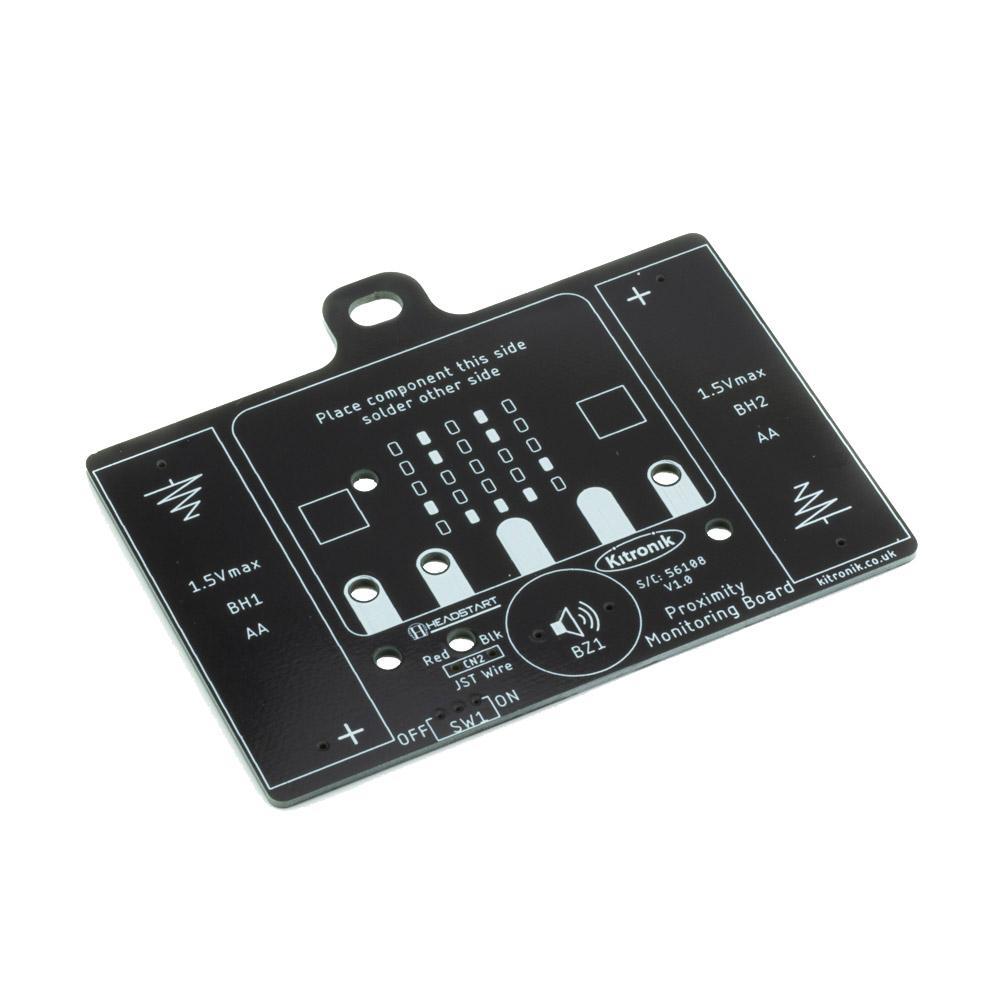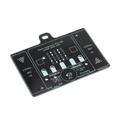We are open! Orders will ship today as usual.
Kitronik Proximity Monitoring Board - PCB Only

Description Links Attachments
This PCB has been designed as an open-source platform for building and learning about proximity alarms (social distancing) using the micro:bits radio functionality. This can also serve as a classroom activity to highlight how social distancing works, specifically in the school environment. Once built it can be used with a lanyard so students can wear the completed proximity alarm for testing/use.
This board has been designed in conjunction with our friends at Headstart Technology in Malta. As we want to make this design available to anyone who will find it useful Headstart Technology has created a GitHub that will contain the PCB files and software used for the design. Visit the GitHub here.
The system makes use of the radio module of the micro:bit in two ways. Firstly, all micro:bits in one 'bubble' should share the same radio group, eg radio group 1. Secondly, the micro:bit radio signal strength turns out to be a reasonably accurate way of measuring distance. Each bubble should be set to its own radio group. If anyone from another 'bubble' approaches group 1 then a sounder gives a beep of alarm. This can be set up to cover all of the bubbles in a school so that anyone who gets too close to anyone who isn't in their bubble will be warned off with an alarm. The alarm will not sound if someone approaches members of their own bubble.
This kit has been made with rechargeable batteries in mind and has been tested to ensure that it will work for a week on a single charge. Use the completed board daily and remove the battery for charging over the weekend. To ensure that the batteries are not drained overnight during the week, ensure that the power switch is moved to the off position at the end of the day.
This is supplied as a PCB only, a full list of the requirements for this project can be found below. Although this is an easy build project, some simple soldering is required. There are full build instructions included at the foot of this product description, which also includes a troubleshooting flowchart and other general information.
A repository has been set up on Github with the code required to set up the proximity sensing and it also houses other files such as Eagle CAD files for the board. All of the files are provided as open-source, which allows you to modify them to suit your needs.
Note:
This board has been designed in conjunction with our friends at Headstart Technology in Malta. As we want to make this design available to anyone who will find it useful Headstart Technology has created a GitHub that will contain the PCB files and software used for the design. Visit the GitHub here.
The system makes use of the radio module of the micro:bit in two ways. Firstly, all micro:bits in one 'bubble' should share the same radio group, eg radio group 1. Secondly, the micro:bit radio signal strength turns out to be a reasonably accurate way of measuring distance. Each bubble should be set to its own radio group. If anyone from another 'bubble' approaches group 1 then a sounder gives a beep of alarm. This can be set up to cover all of the bubbles in a school so that anyone who gets too close to anyone who isn't in their bubble will be warned off with an alarm. The alarm will not sound if someone approaches members of their own bubble.
This kit has been made with rechargeable batteries in mind and has been tested to ensure that it will work for a week on a single charge. Use the completed board daily and remove the battery for charging over the weekend. To ensure that the batteries are not drained overnight during the week, ensure that the power switch is moved to the off position at the end of the day.
This is supplied as a PCB only, a full list of the requirements for this project can be found below. Although this is an easy build project, some simple soldering is required. There are full build instructions included at the foot of this product description, which also includes a troubleshooting flowchart and other general information.
A repository has been set up on Github with the code required to set up the proximity sensing and it also houses other files such as Eagle CAD files for the board. All of the files are provided as open-source, which allows you to modify them to suit your needs.
Note:
- BBC micro:bit is NOT included.
- This board works with all versions of micro:bit.
- Some soldering required.
- Learn about proximity alarms and how to apply this to social distancing applications.
- Fully open-source, with code and schematics and PCB designs provided.
- Teach social distancing in a practical and hands-on way.
- Full build instructions available.
- 1 x Kitronik Proximity Monitoring Board - PCB Only.
- Length: 62mm.
- Width: 90.9mm.
- Height (with lanyard clip): 6.2mmm.
- PCB Thickness: 1.6mm
- BBC micro:bit.
- A switch.
- A sounder, if using a micro:bit V2 you can use its onboard sounder instead.
- AA Battery Holder.
- 1 x AA Rechargeable Battery.
- Wire with JST connector.
- 2 x M3 12mm Bolts.
- 2 x M3 plastic nuts.
- 2 x 6mm Plastic spacers.
- Soldering Iron.
- Solder.
Properties
Brand information
| Brand | Kitronik |
| Model | 56108 |
€ 5,20€ 4,30 Excl. VAT (NL)
Customer questions
Q
Customer Reviews
Kitronik Proximity Monitoring Board - PCB Only ★★★★★Click a star to leave your review
- In stock Kitronik 2xAAA Battery Cage with JST Connector € 1,45 View product
- In stock Kitronik Electro-Fashion, Switched Coin Cell Holder - CR2032 € 2,55 View product
- In stock Kitronik Electro-Fashion, Light Sensing Coin Cell Holder € 4,90 View product
- In stock Kitronik USB Power Lead € 1,60 View product
- In stock Kitronik 1xAA battery Cage with Leads € 1,25 View product
- In stock Kitronik Sewable Miniature Coin Cell Holder - CR2032 € 2,10 View product
- In stock Kitronik :MOVE Motor Klaw Kit € 9,20 View product
- In stock Kitronik MI:power board for the BBC Microbit V2 € 5,60 View product
- In stock Kitronik Round USB RGB LED Lamp € 8,65 View product
- In stock Kitronik 5V LED Desk Lamp Kit € 3,65 View product
- In stock ZIP LEDs Add-On Pack for Kitronik Inventors Kit for micro:bit € 13,70 View product
- In stock Kitronik 1F Super Capacitor, 2.7V € 0,90 View product
- 10 pieces In stock Kitronik Electro-Fashion, LED Board - White - 10pcs € 4,75 View product
- In stock Noise Pack for Kitronik Inventor's Kit for the BBC micro:bit € 15,50 View product
- In stock Kitronik 16GB Memory Stick, Uncased € 9,25 View product










